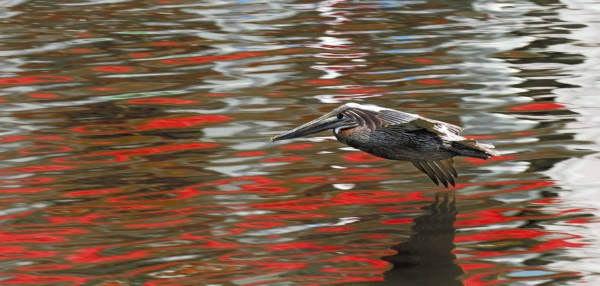Wayne Hinshaw: Exploring the ordinary and finding the extraordinary
Published 12:00 am Sunday, July 12, 2015

- Wayne Hinshaw / for the Salisbury Post A brown pelican skims the top of the water of Shem Creek in Mt. Pleasant, SC. The red reflection is from a nearby restaurant with a red roof.
Mt. Pleasant, S.C. — I suppose it was my curiosity and having a free afternoon that brought me to Shem Creek Marina in Mt. Pleasant. I love to get out and explore places where I have never been before. I am always excited about what I might find around the next curve in the highway or in the waterways under the bridges.
That curiosity pulls me to situations or places that I immediately love and start photographing. I ran across a small advertisement in a “things to do list” while on vacation. The small promotion suggested taking a tour of the Old Village in Mt. Pleasant. The Old Village is an area of historic residential homes on the waterfront of the Cooper River and the Charleston Harbor.
While there, cruising around on a very hot afternoon and running into many dead end streets, I stumbled upon the Shem Creek Marina. It was a wonderful discovery. It is a beautiful place with commercial fishing docks and shrimp boats, restaurants, taverns, even a wooden walkway out over the wetlands and swampy backwaters.
Walking down to the wooden fishing dock, I see the creek on my left that is full of activity with people and boats. There are five or six very large, nice restaurants on both sides of the creek.
There are “photos waiting to be made” all around me. Heaven must be like this for a photographer. Ansel Adams said, “A good photograph is knowing where to stand.” That is my problem, there are too many good places to stand for photos, and I just have to try the view from each location.
Young paddle board riders standing on their boards paddle past me and then back again. The crew from one of the docked shrimp boats is resting in the shade on the boat, exchanging stories and sharing beers and laughs. I think they are Vietnamese. I didn’t know the language, but at least they are of Asian backgrounds.
Seagulls are nose-diving off the dock pilings, squawking their annoyance at me for disturbing their peace. Endangered brown pelicans glide just above the surface of the water, looking so graceful and effortless in flight up and down the creek.
Where to stand for that photo? If I stand in line with the red-roofed restaurant across the creek, the red color reflects perfectly off the texture of the water. Yes, that is a good place to stand. I like that reddish water.
Further down the creek, a fisherman on his boat is cleaning out his bait box, with a dozen or so pelicans waiting for an easy meal. They are waiting in a line around his boat. They know he will toss them some small bait fish for their effort.
Here I am, using my camera to record images of beauty in hopes that others looking at the images might learn to see the same image without having to put cameras in front of their faces. There are always two people involved in each photo. The photographer is part of the photo in seeing an image, and the viewer is the second partner in viewing the image. Oh, but sometimes the viewer sees a different image from his perspective than what the photographer was seeing when taking the photo.
Here I am trying to describe my photos in words when photographer Elliott Erwitt once said, “The whole point of taking pictures is so that you don’t have to explain things with words.” I think sometimes words help you see what I saw through the camera.
As boats move slowly up the creek, dolphins follow the boats to their dock. The dolphins, sometimes two or three at a time, seem to be providing a safe escort for the boaters. Oh, well maybe the dolphins are just bored and are swimming for a little excitement. They follow a boat in and swim back out. They follow a boat in and swim back out, repeating the trip over and over all afternoon.
I guess it is about time for me to move on. I have spent the afternoon observing life around the creek. Again to quote Elliott Erwitt: “ … Photography is an art of observation. It’s about finding something interesting in an ordinary place … I’ve found it has little to do with the things you see and everything to do with the way you see them.”
I hope you see these ordinary things the way I see them today.

